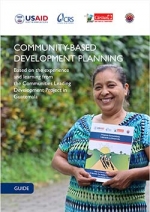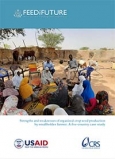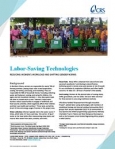Guidelines | October 16, 2023
Community Based Development Planning
In the seven-year period between 2016 and 2023, USAID and CRS implemented the Communities Leading Development (CLD) Project. This project worked intensively with more than 200 rural communities in the Western Highlands of Guatemala, building their capacity to lead a highly participatory and inclusive process to define a vision for their communities’ long-term development and then mobilize resources to respond to their top development priorities. The CLD Project facilitated community-based development planning that resulted in 203 Community Development Plans, collectively representing the participation of 27,652 community members (38% women), the implementation of 627 focus groups and 378 community assembly meetings and more than $325,000 in community leverage contributions (considering the time of community members invested in the process). In parallel, more than 3,500 community leaders (both official and informal community leaders) participated in a training program to strengthen their capacities to lead community-based development planning and subsequently design and manage projects responsive to the Community Development Plans.
Once finalized, the Community Development Plans collectively became the roadmap for CLD resource mobilization efforts. The project registered 762 completed projects responding to community defined priorities, directly benefitting 17,796 households. Critically, the communities used their Community Development Plans to influence public and private investment in line with their own priorities. A total of $46.5 million was registered in cash and in-kind contributions from the private sector (56%), the public sector (28%), the communities themselves (10%) and the international cooperation (6%) to implement the Community Development Plans. The plans were such an effective resource mobilization tool that the collective efforts promoted by the project achieved $1.29 in leveraged resources for every $1.00 of USAID investment.
An alliance with Guatemalan Government’s General Secretariat of Planning and Programming (SEGEPLAN) has led to SEGEPLAN adopting CLD’s methodology and tools for community-based development planning as part of their own suite of planning resources. SEGEPLAN previously offered methodologies and tools for planning processes from the national level down to the municipal level, but notably lacked such guidance for the community level. SEGEPLAN’s adoption of the methodology and tools is also a means for community level development planning to formally feed up to higher levels of government for development planning and decision-making with regards to investment of public resources.
One of the main challenges of the community-based development planning methodology used by CLD was the significant time investment required by project staff, community leaders and other participants in the process. The purpose of this guidance document is to present a simplified process for community-based development planning that can reasonably be implemented in four months or less (thereby requiring fewer resources to implement) and that takes a ‘good enough’ approach to consensus building on community priorities needed to catalyze sustainable community development. This guidance document was developed based on lessons learned from the field, considering the elements that were most valued by the communities, strategies to maintain high levels of community interest and participation and opportunities to streamline yet still yield high-quality products. As such, this guidance document outlines a community-based development planning methodology that is adapted based on the learning from the CLD Project. Throughout the document, links are provided to CLD and other CRS manuals, tools and examples1, with the understanding that users of this guidance document will adapt them for different contexts and opportunities.
This guidance document is primarily oriented to 1) senior technical and business development staff with interest in practical guidance on incorporating community-based development planning into future proposals and strategies, and 2) technical staff tasked with applying and adapting the guidance to the needs of a particular population, sectoral focus, etc. The remainder of this document is dedicated to describing the links between community-based development planning and CRS Program Quality Standards, step-by-step guidance for implementing the process and operational and budgeting guidance.





